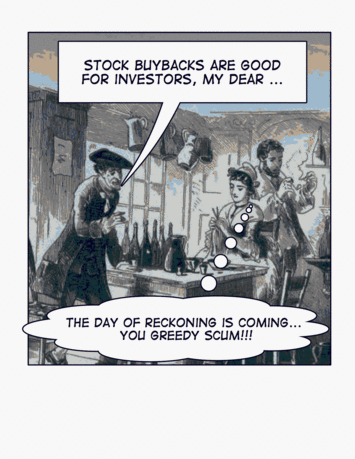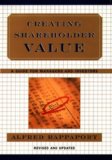Buyback bear rages: the worst is yet to come
by John Schroy filed under Capital Flow Analysis, Equities, Corporate Managers, Individual Investors, Foreign Investors, Insurance Executives, Fund Managers, Equity Risk
On September 17, 2020, Capital Flow Watch called the top of the Buyback Bubble, issuing a warning that stock prices might be in for a sharp fall. Unfortunately, that comment turned out to be correct.
The outlook considered two simple facts:
- Stock prices are supported by equity buybacks, which, in turn, now depend upon loans for funding.
- The sub-prime mortgage event that started in July 2007 and the ensuing credit crunch, reduced money available for buybacks, weakening a support of equity prices.
This forecast was based on long-term trends concerning buybacks and equities, not on current numbers — the Federal Reserve publishes flow of fund accounts with a three month lag.
Now that we have the figures for Q3 2007, its possible to further access the situation and look forward.
US corporations are running out of buyback money
Federal Reserve flow of funds table F.102 (Nonfarm Nonfinancial Corporate Business) shows that in Q3 2007, corporate profits after taxes and dividends were at an annual rate of $232.1 billion. However, corporations were buying back their own stock at an annual rate of $446.8 billion.
Buybacks are no longer just “another form of dividends” as management has often claimed, suggesting profits as the source of funds. Rather, buybacks are now financed out of depreciation reserves, and most importantly, from borrowings. They are, in large part, a return of capital — mostly to people who never put up capital in the first place.
During 2007, credit rating agencies (often the last to spot danger), awoke to the risk of equity repurchases and began down-grading corporations that used debt to finance buybacks. Despite this, the buyback frenzy continues.
Moreover, in Q3 2007 something extraordinary happened: US corporations began to borrow abroad — in huge amounts. Because money is fungible, much of this went into stock buybacks.
In Q3 2007, the net increase in corporate borrowing from the “Rest of the World” was $232.7 billion, compared to annual rates that were often negative and never exceeded $28.3 billion from 2003 to 2006.
It takes ever greater amounts to keep stocks rising with buyback cash.
The flow of funds accounts reveal a grim picture. To give value to their stock options, executives, as a group, cut dividends to shareholders, diverted funds from depreciation reserves, issued bonds, even risking a fall in credit ratings, and , scraping the bottom of the barrel, so to speak, accelerated borrowing from aboard.
For equities, buybacks are the only game in town
Capital Flow Analysis is based on the premise that stock prices are not driven by earnings ratios, financial statistics, or “instrinsic value” (whatever that is), but rather by the raw force of motivated buyers facing more or less motivated sellers, as measured by the amount of money each party brings to the table.
In the equity market in Q3 2007, the principal buyers were (net flows, annualized):
| US nonfarm nonfinancial corporations (buybacks) | $846.0 billion |
| Insurance companies | $94.1 billion |
| Mutual funds | $58.0 billion |
| Closed-end funds | $31.5 billion |
On the buying side, most money comes from buybacks.
Mutual fund net purchases of $58 billion (often representing automatic investment through 401(k) plans and IRAs), is way down from comparable figures of between $129.6 and $158.5 billion from 2003 to 2006.
On the selling side, comparable figures are:
| Households | $563.0 billion |
| Foreign equity issuers | $192.8 billion |
| Pension, retirement funds | $125.5 billion |
| Broker dealers | $52.7 billion |
The motivation of the sellers is not hard to divine:
- foreign issuers are raising money in an equity market where capital is cheap;
- pensions, retirement funds, and broker-dealers are sophisticated players, selling because stocks are over-valued.
The motivation of the “households” category is also not mysterious.
This is a behavior that has persisted for a generation. Most household net selling represents corporate executives (and perhaps hedge funds going along for the ride) cashing out stock options.
The same guys on both sides of the market
So here we have the equity market in a nutshell.
On the buying side there are corporate executives ordering buybacks, using money that rightfully belongs to shareholders.
On the selling side we also have corporate executives exercising options and cashing in on buybacks they ordered.
Is this fair? Is this even a real market? Could there perhaps be a greater conflict of interest? What are the odds that corporate executives (wearing their executive hats) will overlook their greed and remember their fiduciary duty to shareholders?
No, no, no, and none.
Why ignorance is not bliss
As long as Wall Street and the Federal Reserve think that tinkering with short term interest rates will save the equity market, ignoring the effect of buybacks on equity prices and the motivation that drives the market, there is little chance that the outlook for equities will improve.
Here is why:
A corporate executive, once he or she reaches the pinnacle of power with a hand on the buyback lever, knows that this is a last and only chance to feed at a trough that has enriched so many for over a generation. If Wall Street is applauding buybacks and if shareholders don’t know any better, why not keep on feeding? Morality, after all, is based on common perception. No one has ever gone to jail for cheating investors through buyback schemes.
The SEC doesn’t care and even approves. The Federal Reserve says nothing and seems ignorant. Candidates of both political parties keep mum. Neil Cavuto, Lou Dobbs, and the Wall Street Journal have no comment. Fund managers and Wall Street analysts cheer each decision to increase buybacks. It is as if the Federal Reserve flow of funds accounts didn’t exist.
But buybacks are not free nor without consequences. They cost corporations their reserves against hard times, funds for long-term investment, and financial stability. This, of course, won’t stop executives who weigh cash in their own pockets today against the welfare of distant, almost mythical shareholders at some future date — when, as Keynes said, we all will be dead.
By weakening companies and eroding shareholder trust, a disservice is done to the system and to future generations, as corporate savings are diverted to non-productive ends. But never mind.
Even as stock prices fall, executives can find ways to readjust the value of their options downwards — after all, without stock options how could corporations attract “the best talent”?
So the only real brake on stock buybacks is how much money corporate executives can scrape from profits, reserves, dividends, and unwary lenders.
Sophisticated investors look elsewhere
From the Q3 2007 figures, we see that sophisticated investors and even mutual fund savers, are moving away from equities. As baby boomers being to retire and switch from equities to bonds, mutual fund interest in equities will decrease.
The credit crunch is certainly not over; big banks are being chastised for their profligate ways.
The rating agencies are onto the game.
Sooner or later the money for buybacks will dry up, but meanwhile, the market continues to fall as executives becoming more and more excited at the last chance to cash out their options.
An improbable solution
There is, of course, a way to stop all this.
The SEC, the Federal Reserve, and the political leaders would have to come together and condemn buybacks, insisting instead that if executives are to be rewarded for “performance” it should come through dividends paid to stocks that they, like everyone else, have paid for in full. After all, if this was good enough for Andrew Carnegie, why not for modern would-be moguls?
If this happened, cash dividends would shoot upwards. Stock would become worthwhile investments, based on dividend yields that, like in olden times, would surpass bond yields. Dividend yields would brake falling prices. Executives would be motivated to invest in the future and increase dividends. It sounds just like capitalism!
However, fat chance! Don’t count on it.
There are thousands and thousands of corporate executives, fund managers, and broker-dealers that know nothing else than the buyback culture. These people are not going away and have a lot of money to fight reform.
As for the economy saving the stock market, in the best of circumstances, it will take time to mend the banking system. A harder look at big loans for foolish purposes by weakened banks, will not help corporations anxious for funds to buy back stocks from their own executives.
With recession at hand, the American political outlook offers a return of the Clintons (with higher taxes and increased government regulation) or of someone like Mitt Romney, a former corporate executive, who has said that in the first crisis he would call in McKinsey & Company, the consultants to Enron.
Of course, there are good investments still out there, even among equities, and there will be even more as the recession deepens, but here we’re examining the immediate direction of the stock market, based on flow of funds analysis.





